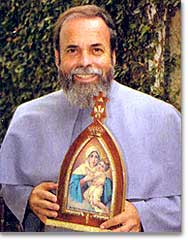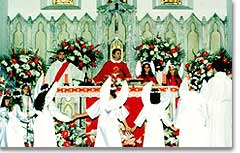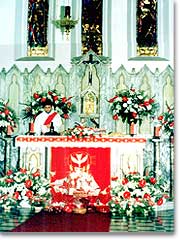 |
| Padre Antonio
Maria Borges con su Peregrina - iniciador de la Campaña de
la Virgen Peregrina en la comunidad portuguesa en Ciudad de Cabo. Father Antonio Maria Borges with his Pilgrim MTA,initiator of the Schoenstatt Rosary Campaign in the Portuguese Community of Cape Town P. Antonio Maria Borges mit seiner Pilgernden Gottesmutter - Initiator der Kampagne der Pilgernden Gottesmutter in der portugiesischen Gemeinde in Kapstadt Foto: Maria Mãe, São Paulo |
 |
| Un rosario
y un gran imagen de la MTA para la peregrinación de los Portugueses A rosary and a big picture of the MTA for the pilgrimage of the Portuguese Ein großer Rosenkranz und ein Bild der MTA für die Wallfahrt der Portugiesen |
 |
| Misa de Pentecostés Pentecost Mass Pfingstmesse |
 |
| Flores y
colores... Flowers and colors... Blumen und Farben... |
| Foto: Sr. M. Kathleen © 2002 |
SOUTH AFIRCA Sr. M. Kathleen. South Africa is a country in which people of many different nationalities have found a home. The Portuguese community in Cape Town had "caught fire" for the Pilgrim Mother. On November 17, many of them came to the Shrine in Cape Town to pray the Mysteries of Light and be introduced to the Year of the Rosary.
How it all began? At the beginning of 2002 a group of Schoenstatt Fathers from different countries came to South Africa for a tertianship. Father Benito Schneider and Father Antonio Maria Borges from Brazil were among them. These two Fathers also celebrated Holy Mass for the Portuguese community in one of the Cape Town parishes.
They entered the Church in procession carrying an image of the Pilgrim Mother which then received a prominent place on the altar. Father Antonio is a famous singer and his contribution made the Eucharistic celebration very special. During his sermon, he referred to Our Lady as the Pilgrim Mother and, at the end of Holy Mass, Father Benito, who has the responsibility for the Pilgrim Mother in Brazil, spoke at length on the subject. From that day on, many circles have been formed around the Pilgrim Mother.
First Portuguese Pilgrimage to the Shrine in Constantia
In October, the Portuguese people came for the first time as a cultural community on pilgrimage to Schoenstatt, Constantia. We had a very large Pilgrim Mother made for the day. This image has since been used for other occasions.
The Portuguese priest who came with the pilgrims could not sufficiently express the joy and gratitude of the people for having come to this place of grace. The Rosary was recited before Holy Mass and people stayed until late afternoon for private prayer. They simply enjoyed this ‘beautiful place’, which really was at its best on a glorious Spring day.
Pentecost experience
The Portuguese community values the traditions and religious customs of their country. On Pentecost, the Portuguese community celebrated the Holy Spirit’s coming. The courtyard outside the church was beautifully decorated and the flowers in the church were magnificent! There were at least a few hundred deep red anthyriums mixed together with white chrysanthemums. In every arrangement there was a beautiful dove made of white feathers, a symbol of the Holy Spirit.
The celebration started with a procession around the school grounds. With hymns and prayers, we called upon the Holy Spirit to come down upon us. The culture of the people was deeply incorporated into their religion. Many children wore their national costume, while the adults, both men and women, were obviously aware of their national identity. Royal insignia were carried in the procession.
Living in a society where violence, crime and drug-addiction are everyday experiences, I thought I was on an island. The Portuguese community keep very much together and celebrate feasts as they occur. They have certainly managed to retain a deep and generous love for God, for Our Lord and his Blessed Mother. With a deep childlike spirit they expect everything from God, while their trust and confidence in Our Lady can only be admired.
I could only think how much potential lies within this community for Schoenstatt’s spirituality, the covenant of love and instrumentality.
A rosary made from corks
In September, the Portuguese community celebrated the beginning of the fishing season in South Africa. At the "Waterfront" in Cape Town, a huge tent had been erected to host all the events that were to take place there, both social and religious. On Sunday morning Holy Mass was celebrated and the boats were blessed. Once again, a rosary procession through the streets preceded the solemn Holy Mass. Archbishop Lawrence Henry, the Archbishop of Cape Town, led the procession and two floats were carried in the procession, one with St Peter the fisherman and the other carrying the statue of Our Lady of Fatima. A group of men carried a very large Rosary made from corks that hold a fishing net together. Holy Mass was then celebrated, after which the boats were blessed and two of them were honoured to carry the two floats with St Peter and Our Lady around the harbour and a little way out into the open sea.
Mysteries of Light with the Holy Father
On 17th November 2002, members of the Pilgrim Mother Campaign came to Schoenstatt, Constantia (Cape Town) to be introduced to the ‘Year of the Rosary’. The people gathered around the Shrine in glorious Summer weather. An ‘altar’ had been built up outside the Shrine with a large replica of the Pilgrim Mother decorated with flowers and a big Rosary. The celebration consisted of texts from the Apostolic Letter of our Holy Father, after which the luminous mysteries (the ‘mysteries of light’) were led by a Deacon and recited by the people. By means of a tape recording, we could listen to the Holy Father praying the first Our Father and three Hail Marys in Latin. Then we continued with our own celebration.
Each mystery was introduced by a reading from Holy Scripture, a meditation on the reading and a practical application to everyday life. Time was given to reflect and sing hymns in between the mysteries. After devotion and Benediction, the Pilgrim Mother pictures were blessed and distributed from the Shrine. Everyone felt ‘at home’ with Our Lady and were happy to be sent out into our needy world as messengers and apostles of peace and love.
The graces from the Schoenstatt Shrine
In paragraph seven of his Apostolic Letter, the Holy Father says that the Marian Shrines of Lourdes, and Fatima, among others, "continue to be visited by great numbers of pilgrims seeking comfort and hope." The Blessed Mother also in her Schoenstatt Shrine gives comfort - the grace of having a home - , and hope - the grace of inner transformation-. But there is a third grace that the Mother Thrice Admirable of Schoenstatt is willing to render from her Shrine, and she does so with special strength and a certain preference. When someone has received comfort in abundance, and when hope in his life has begun to work in view of inner transformation, this creates the irresistible longing to share with all thise around the graces recieved by Mary. This is the grace of apostolic fruitfulness, that obviously the Blessed Mother from her Shrine in Constantia is willing to give to her instruments that set out to carry her picture to the ends of the world so that the world may see her graces and be filled with peace and love.